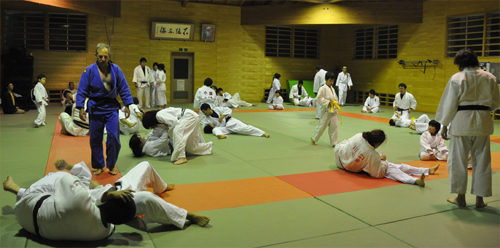During my trip to Japan in December 2010, I had the pleasure of visiting the Yamagata University Medical School Judo Club, coached by Dr. Hiroshi Takei, a former student of mine. In spite of the name, the club has a large children’s program in addition to the university players. I attended two practices. Dr. Takei invited me to teach the last hour of the second practice. When I asked him what he would like me to cover, he half laughingly said, “Transitions,” an obvious choice.
Traditional Judo training, whether in Japan or the United States, revolves mostly around practicing parts of single, isolated techniques, and then repeating the same process in randori with the exception that full techniques are now expected. Absent are the transitions from throw to throw, whether combinations or counters, and from tachi waza and ne waza. And forget about the ne waza to ne waza transitions since thanks to the IJF rules ne waza is such a small part of modern Judo.
Japanese players are always looking for the big “ippon” throw, which is based on their tokui waza. In the process, they tend to ignore a multitude of scoring opportunities based on transitions. Of course, if you don’t practice those transitions, you can’t take advantage of them when they materialize in randori or shiai.
So, for one hour I put the Yamagata players through a series of transitional sequences: skills they had never done or thought of doing before. I have found that Japanese players I have coached in the U. S. are very interested in my ideas on Judo training. They quickly understand the logic behind my approach, and they appreciate the refreshing change of pace and instructional content. It was no different with the Yamagata players.
During the session, I paused to ask them whether they were uncomfortable or felt incompetent practicing my style of Judo. They were neither uncomfortable nor felt incompetent, but Dr. Takei in a side remark to me suggested they were curious why a gaijin, a foreigner, was teaching them Judo! That’s fair considering the overwhelming success of Japanese judoplayers in international competition, and even more fair considering that the gaijin in question was an American. What could an American coach teach Japanese players about a sport invented by the Japanese? Well, the answer is that he could teach them plenty.
In my opinion, the success of Japanese Judo in the international arena is not based on science of training or quality of coaching. Rather it’s based on numbers. Although Japan is smaller than California, the state I live in, its general population is more than three times larger than California’s. And when it comes to the Judo population, the numbers are simply staggering. We might have 3,000 players in California (and perhaps 30-40,000 in the entire USA), while the lowest estimate I have heard suggests that Japan has 200,000 players. It becomes even more depressing if you take into account the higher estimate of several million players.
You must also factor in that Judo is an institution within secondary schools, universities, and many industry companies. This enables them to reach in greater numbers and sooner than the rest of the world the 10,000 hours of training required to master the sport. Can you now start to understand why the Japanese are so successful?
Many foreign coaches have made contributions to sports born in the USA or Europe. I don’t see why the same can’t be accepted for sports born in Japan. I will admit that we are lucky the Japanese look down on us with disdain. If they incorporated our best ideas and methods, we wouldn’t stand a chance.




Hello.My name is pranav modi from Mumbai(Bombay).I Have done M.B.A in Finance.I am a judo student. I liked this article very much. I came to know some new things in Judo.The article was really interesting.Glad to see that judo is popular internationally ,even in America.thank you sir